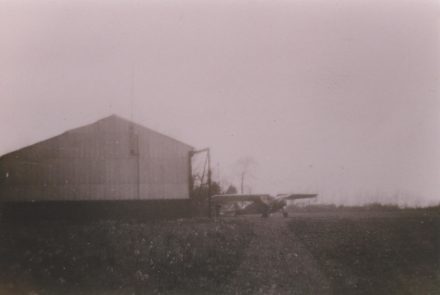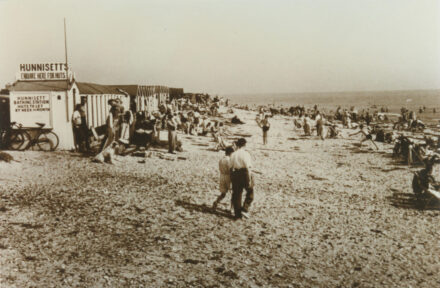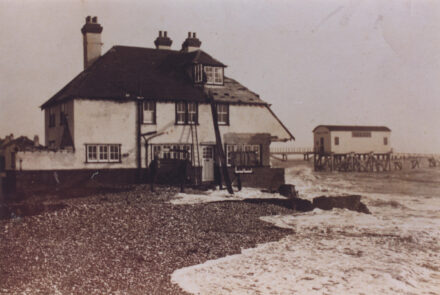The name of Harry Hunnisett will be very familiar to many of us in Selsey, particularly the postcard collectors, as his bathing station appears in many of the pictures. But his story starts in Bexhill, in East Sussex, and at least a generation before his huts were seen in Selsey.
His father, John Thomas Hunnisett (aka Jack) was born in 1849 in Bexhill. In 1881, Jack was a fisherman but by 1891 he described himself as a ‘bathing machine and pleasure boat proprietor’. He was assisted in this enterprise by his wife and eldest daughter. I was fortunate to find his great-great-niece, Cynthia Wright (née Scrivens) who sent me a newspaper cutting from the letters page of the Daily Telegraph in which she writes as follows:
‘…strait-laced Bexhill in Sussex was the first resort, in 1901 to permit mixed bathing. In that town, my great-great-uncle, john Hunnisett, ran the Hunnisett Bathing and Boating Station which, by the early 1890s, was very popular.’ The ‘bathing station’ was on West Parade within spitting distance of the Tramway, the Coastguard Station and the Metropole Hotel (which was sufficiently grand for the Lord Mayor of London to stay there in 1906). Jack was an enterprising man as ithe bathing station is reputed to have been built from the timbers of sailing vessel ‘Isabella’ which was wrecked in Bexhill in 1883.
John ‘Jack’ Thomas Hunnisett photographed by R B Hutchison, 52 Robertson Street, Hastings. A formal pose in which he is wearing thigh-length waders.

And here he is again outside his ‘hut’ on Bexhill Beach. The photographer is unknown. Note lifebelt and personalised sweater

Jack married Sarah Ann Miles in 1875 and they had 7 children, Sarah Ann, John Thomas Guy, Harry Stuart, Agnes H, William George, Alice Mary and Lavinia Kate.
Jack died in in 1893 aged 44. Here again, I am indebted to Cynthia who has been in touch with Grace Stripp, Jack’s great-granddaughter. Grace told Cynthia that ‘Because of a storm, he pulled his huts further up the shore and had a heart attack’. According to Cynthia, ‘Jack’s obituary notice described him as a ‘hard-working man much given to minding his own business and leaving other people alone.’
Neither Cynthia nor Grace had any knowledge of the Selsey connection, so I am pleased to be able to fill in the gaps.
Harry Stuart Hunnisett was born in 1879 in Bexhill. In 1881 he was a scholar and the family lived at Cornwall Road. By 1891 he was a boarder at 22 Cornwall Road with John Henry Ashworth, a boatman. Harry was also a boatman working on this own account. In 1898 the Bexhill-on- Sea Observer of 9 April published a letter which concerned the erection of the proposed bandstand ‘close to Hunnisett’s Bathing Station’ so it is clear that Harry was in business. However things did not run smoothly and in 1901 a complaint was made regarding the behaviour of Mr. Ashworth at the Bathing Station. A further report suggested that Mr Hunnisett be written to informing him that a remonstrance had been lodged by the Council with Mr Ashworth.
For brevity’s sake all further newspaper articles appeared in the Bexhill-on-Sea Observer. On 18 July 1903 a report of an ‘Alarming Incident’ appeared in which a bather nearly drowned. The bather was Dr. Balnit, a Hungarian, who went for a swim after ‘engaging one of Mr Hunnisett’s machines’ and was ‘seized with cramp, and began to shout for help.’ Harry Hunnisett ‘at once went to his aid, and was quickly followed by another boat.’
Happily, blankets and brandy were forthcoming and the patient returned to town ‘practically quite recovered’.
On 7 May 1904 a notice was issued stating that ‘In connection with the case in which two men were fined last Saturday for drunkenness, we are requested to state that Hunnisett, one of the defendants, is in no way connected with or related to the well-known boat and bathing machine proprietor, Harry Hunnisett.’
Also in 1904 there was a ‘Lady’s narrow escape from drowning’ near the Bathing Station but she was rescued.
Happier times were reported on 27 January 1906 when Harry was presented with a testimonial on vellum from the Royal Humane Society which was ‘awarded him for having on July 14th, 1905, gone to the rescue of A E Schaeffer, who was in imminent danger of drowning at Bexhill-on-Sea, and whose life he gallantly saved.
The gold medal which was enclosed in a pretty green plush case, bore the following on the front: ‘Harry Hunnisett – for rescuing a member of the Bexhill Swimming Club…’
Harry Stuart Hunnisett married Alice Woodhouse Kelly and, on 7 May 1906 Patricia Alison Stuart Hunnisett was born hotly followed by Harry Richard Stuart Hunnisett in 1907 and Vera Alice Stuart Hunnisett in 1908.
On 16 July 1910 notice was given that ‘an extraordinary general meeting of the Bexhill Bathing Company, Ltd. Is to be held…to consider an option for the purchase of the bathing and boating business of Hunnisett’s Bathing Station, now carried on by Mr J H Ashworth’. A further notice was issued on 23 July – ‘The Bexhill Bathing Company are already expanding their business operations, having decided to acquire Hunnisett’s Bathing Station next door. This move apparently will enable the Company to cater for customers who still prefer the old type of machine.’

The writing was on the wall as we can see from this notice published on 26 November 1910. Harry had the last laugh though because in December 1910 the bathing station was destroyed by a storm.
And here we have to turn our attention, briefly, to the said John Henry Ashworth. He was born on 23 March 1868 in 1895 he was a Mercantile Clerk. In 1901 he was in Bexhill, aged 33, living at 22 Cornwall Road, a boatman on his own account and in 1911 he was a bathing machine and boat proprietor . I’m sure this address will ring a bell! In fact, John Ashworth stayed at that address until his death in 1948. It is, perhaps, interesting to note that in 1912 and, again, in 1917 he was taken to court for assault, firstly of George Stanbridge and, secondly, of Miss Dove Maud Mary Stern. Both cases were reported at length in the newspapers and John Henry was fined. Perhaps there are events concerning Mr Ashworth which went unreported which re-enforced Harry’s decision to cut and run.

As we can see from the picture of the Colonnade & West Beach, Bexhill was a thriving Victorian town. It had access to a railway as early as 1861 while Selsey’s Tram didn’t arrive until 1897. In 1865 Bexhill had a population of 2,084 while Selsey’s was less than 1000. So why did he choose Selsey? Selsey had a beach and its own bathing entrepreneurs but these were badly affected when two fires, in 1900 and 1909, destroyed many of the huts and tents.
Whatever the reason, in 1911 Harry lived at Eywood Villa, East Street and was a fisherman and Donald Harry Woodhouse Hunnisett was born in Selsey just before the census was taken.
During WW1 Harry was a Merchant Navy seaman serving from 1914-1920. He earned the Star, Victory and British War Medals. He was an AB serving on the ‘Portia’ which was a requisitioned auxiliary to support the Royal Fleet Auxiliary. The ‘Portia’ was requisitioned by the Admiralty on 23 July 1915. On 2 August 1915 she was captured by the German submarine U-28 and sunk by gunfire 70 miles south of the Scilly Isles. No lives were lost. It is notoriously difficult to trace the records of Merchant Navy men so this snippet will have to suffice.
The picture on the right was taken from Google Streetview

By 1913Harry and the family had moved to The Hive, Seal Road.

This is an early picture of Harry Hunnisett in Selsey which formed part of the 1909 mammoth picture collection. The gentleman behind him is Professor Richard Arman Gregory of Bosham but I can find no indication in the press that Professor Gregory visited the mammoth site.
Gregory was Professor of Astronomy at Queen’s College, London, and wrote textbooks on astronomy, chemistry, hygiene, physics and other scientific subjects and ca. 1909 was the country’s leading scientific journalist so I can understand him being interested in the site. Does this indicate that Harry actually arrived in Selsey before he wound up his business in Bexhill?

Be that as it may, Harry established his Bathing Station and beach huts on Marine Beach, Selsey and in this picture we can see the steps going down the ‘cliff’ to the beach below.

Everything seemed to be going swimmingly (if you’ll pardon the pun) but in 1928 ‘A gloom was cast over the residents and visitors to Selsey by the news of the tragic death of Leslie Levy Slater Runge (18).’ Leslie had been bathing with others of the Fulham Boy Scouts on August 8 but went missing. His body was washed up by the tide five days later and an inquest was held at the Pavilion. Donald Harry Woodhouse Hunnisett who, by this time, was running the bathing station on behalf of his father, was called as a witness. The Coroner returned a verdict of ‘Death from Drowning’ adding that there was little doubt that it was accidental. It was reported in the Chichester Observer of 22 August.
Some 13 days later, the Observer was again reporting a tragedy when two young men were suddenly swept out to sea. One drowned but the other managed to scramble to safety. The drowned man was wearing a bathing costume ‘on which was the name of H. Hunnisett’. Frank Sherrington found the body and Ernest John Fullick was called as a witness. ‘P c Osborne went to Hunnisett’s bathing station after receiving the report and ‘was satisfied that everything had been done to try to recover the body from the sea. Mr Hunnisett, his son and witness went out in a boat and searched until 9pm the following day, when they had to give up.’ The Chichester Observer of 4 September describes Harry as a bathing hut proprietor and boatman. He received a voluntary accolade when one of the visitors declared ‘Everything in connection with his bathing station was satisfactory, and people had great faith in him, leaving their children in his charge.’
This picture shows Hunnisetts with a board ‘Enquire Here For Huts’. Another board bears his name and ‘Bathing Station, Huts to Let by Week or Month’.


Finally, we have pictures of the man himself in later life, with grandchildren Patricia Alison Stuart Hunnisett and Harry Richard Stuart Hunnisett….

and another with the famous actor Bransby Williams who had a holiday home in Selsey.

Harry Stuart Hunnisett died, at home, on 16 June 1937 having suffered from an eight months long illness. The Chichester Observer of 23 June 1937 describes him as ‘a popular and a very brave man. He was the bathing hut and pleasure boat proprietor, and a familiar figure to visitors and residents alike, and many are the times he has saved people from drowning, often at grave risk to his own life.’
©Ruth C Mariner
Acknowledgements:
Hurrah for Hastings! – A Celebration by Leonard Scrivens & Cynthia Wright published 2009 by S B Publications. ISBN 978-185770-3498.
Old Ordnance Survey Map for Bexhill-on-Sea, 1908 published by Alan Godfrey Maps, August 2006,
www.alangodfreymaps.co.uk, ISBN 1-84151-927-8
Sussex Photographic Co. Ltd, Hastings
The Story of Bexhill by L J Bartley, published by F J Parsons Ltd, Bexhill on Sea, 1971
Chichester Regis Observer David Philip on behalf of Copydesk.sussex@jpress.co.ukm jpimedia.co.uk
Bexhill-on-Sea Observer
Many thanks for their time and interest to Cynthia Wright and Grace Scripp



